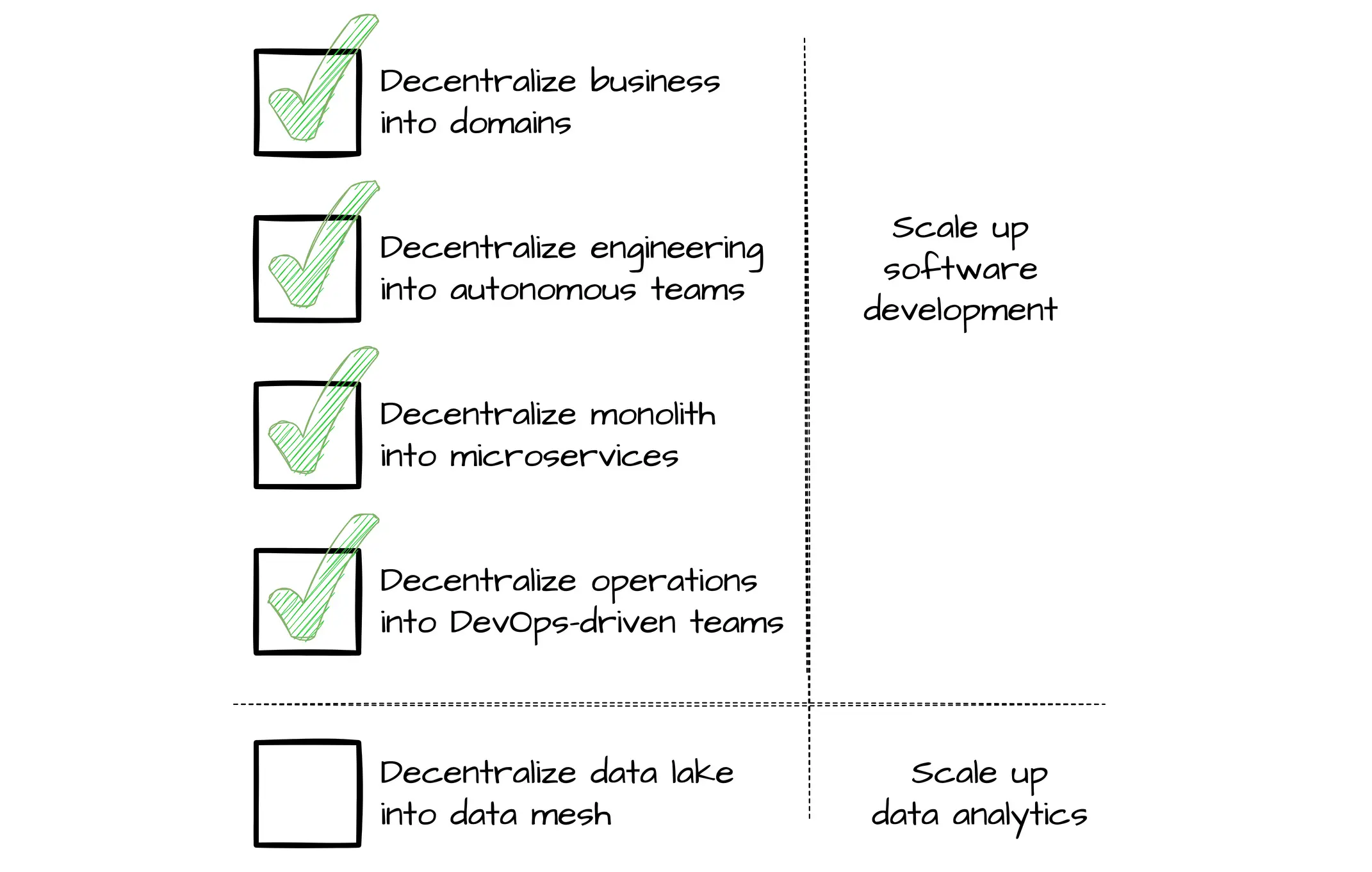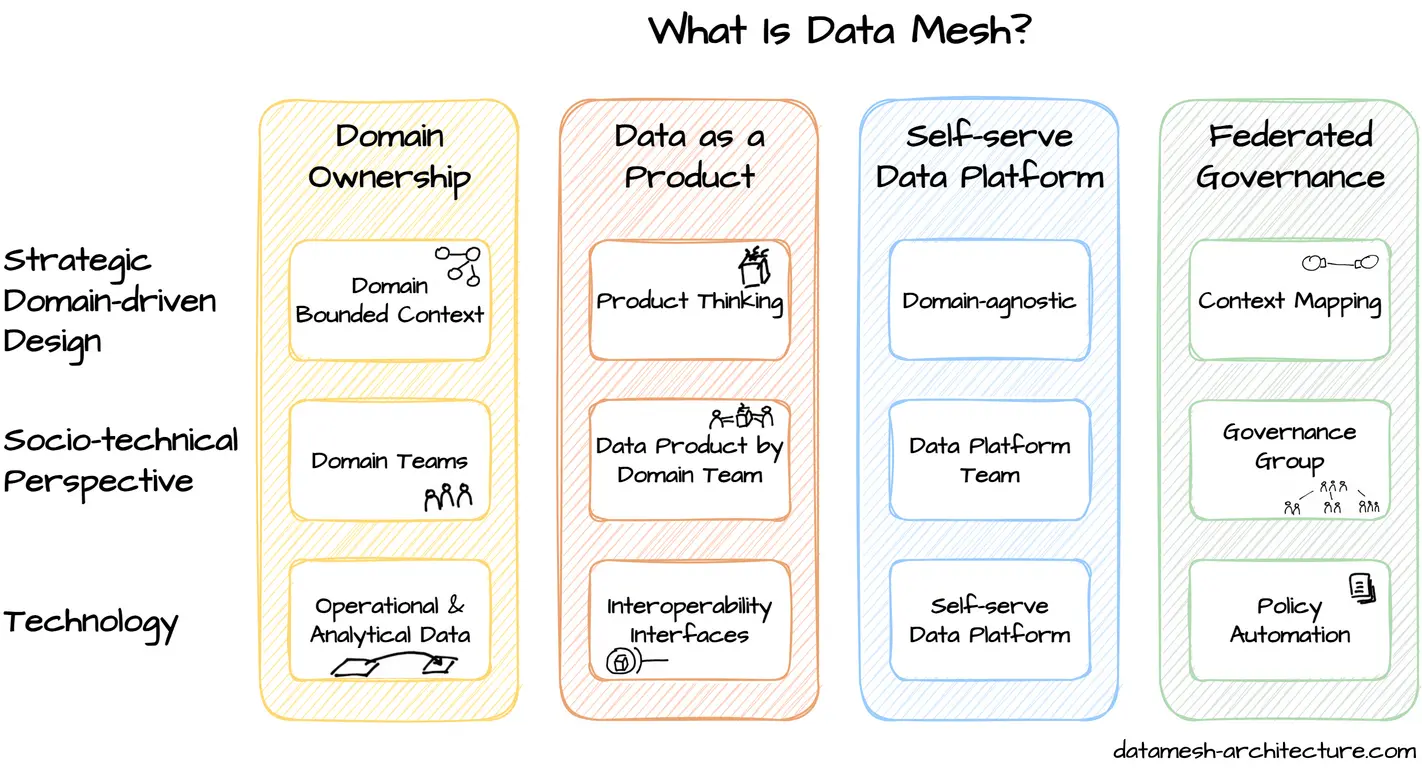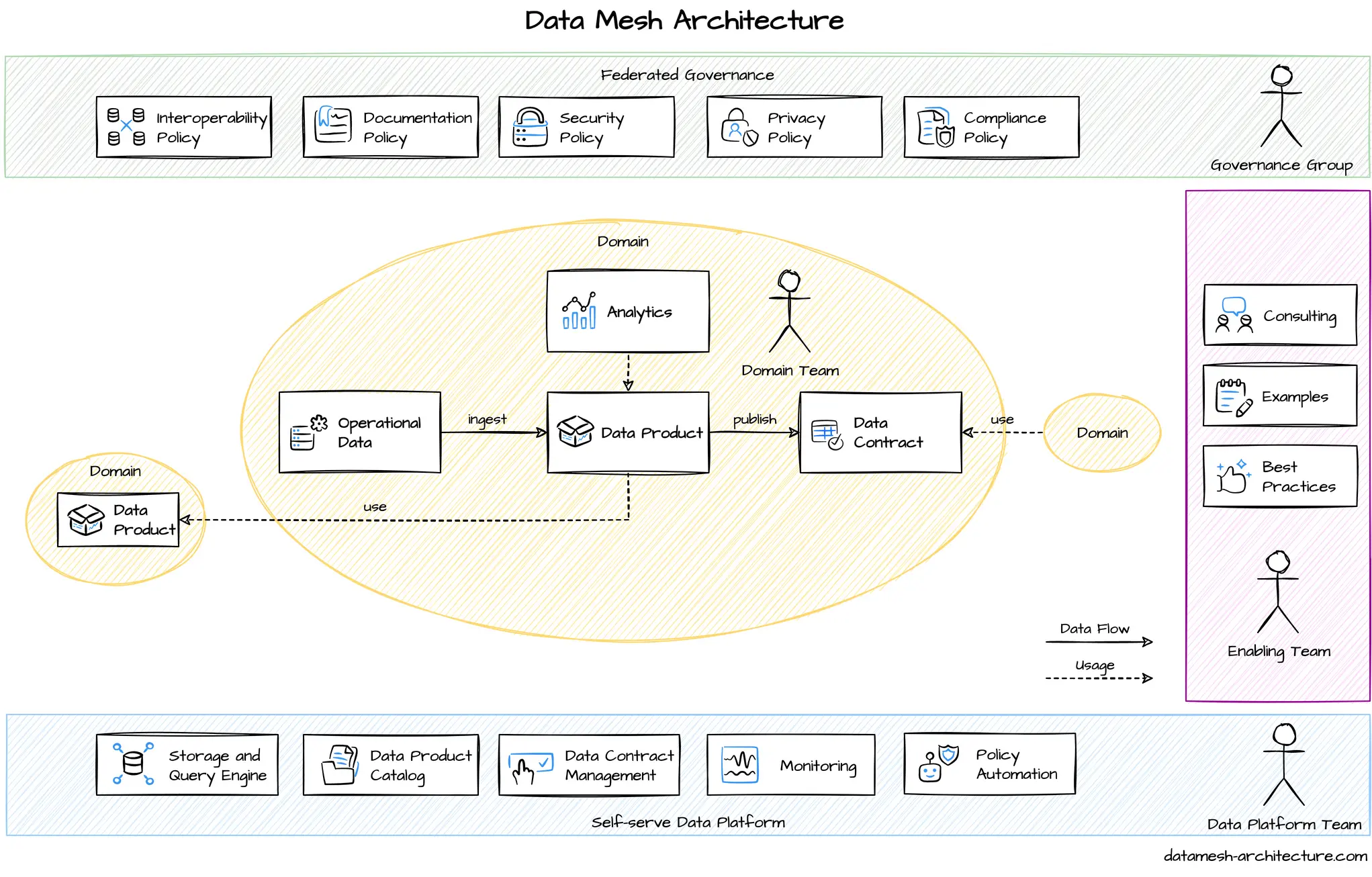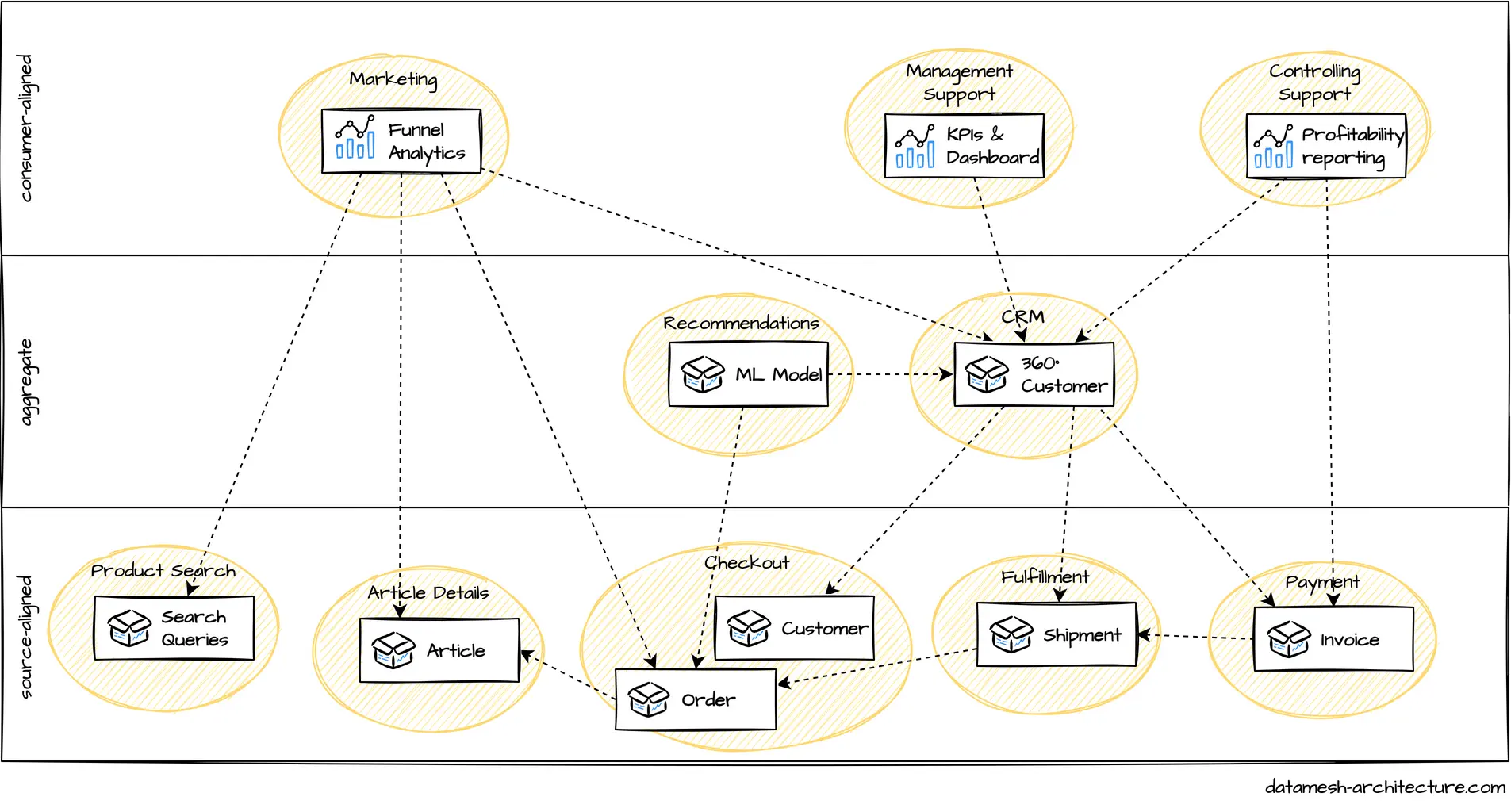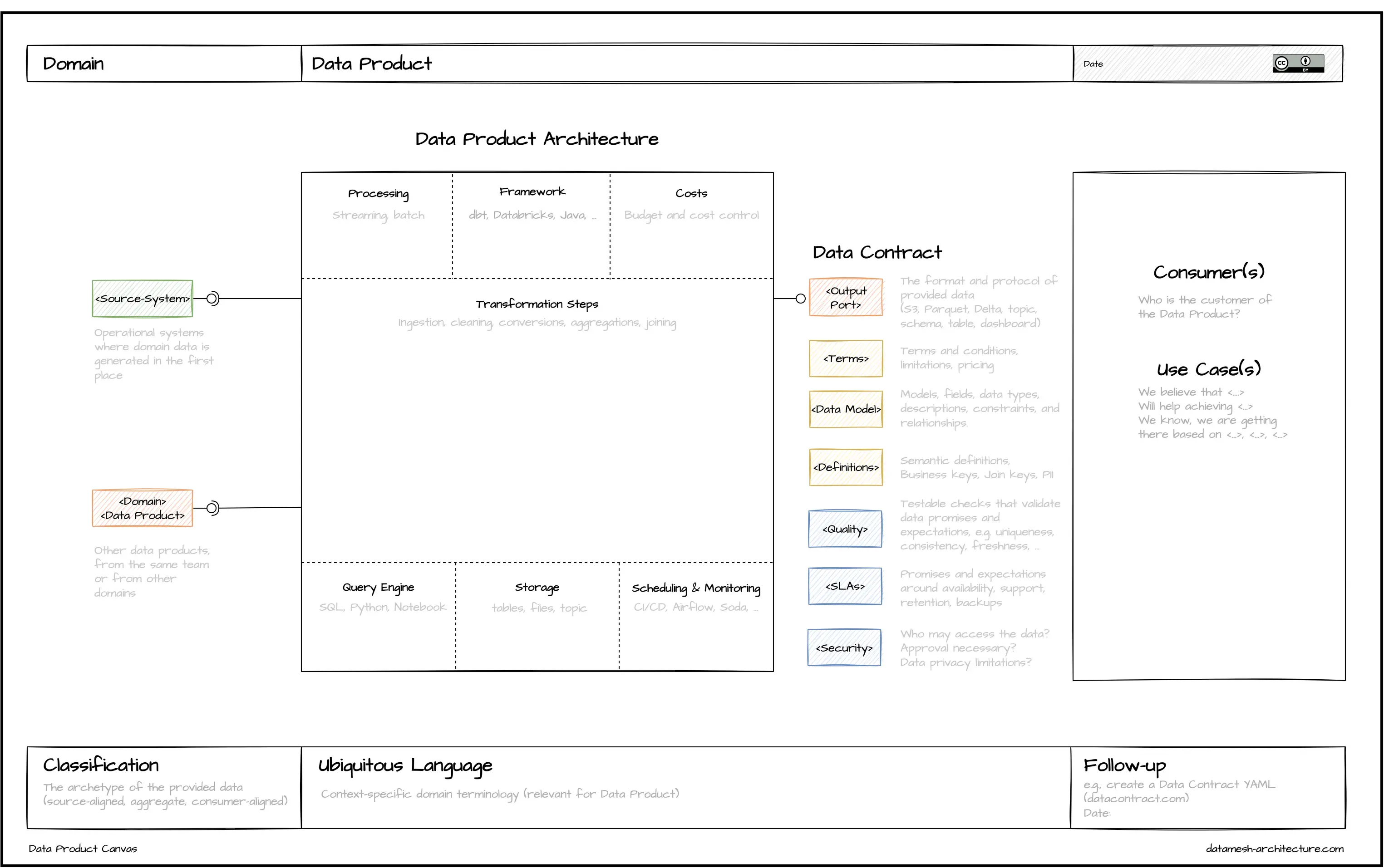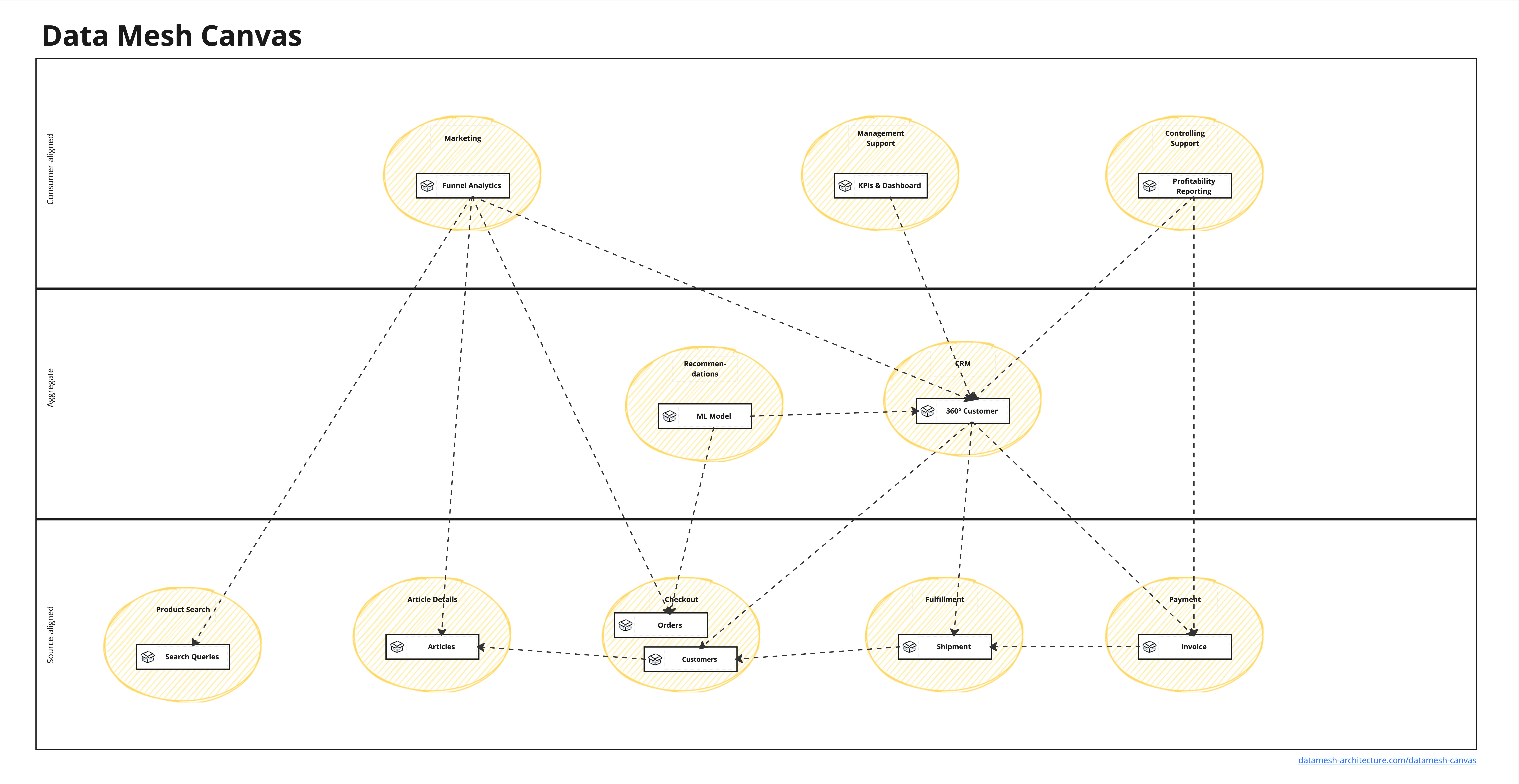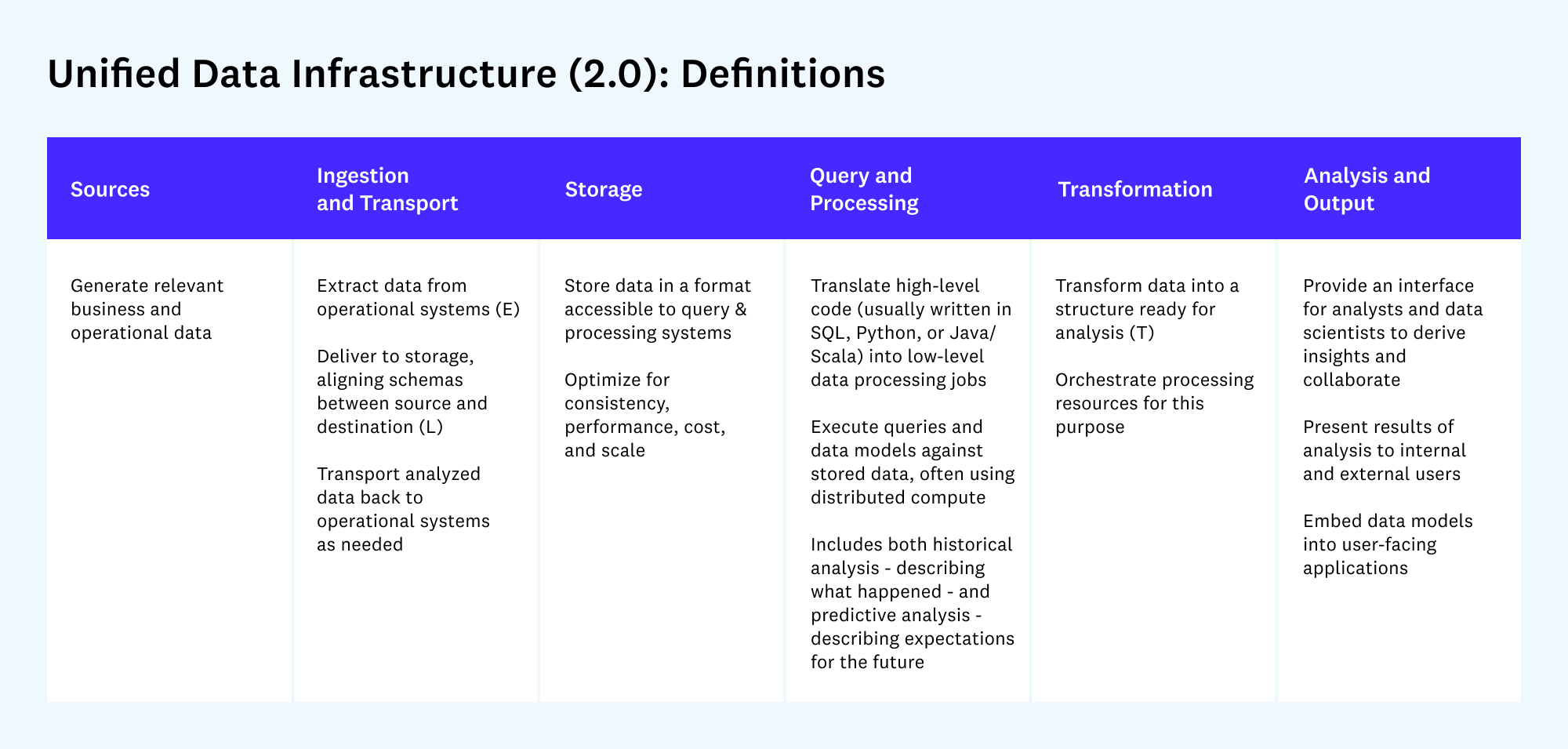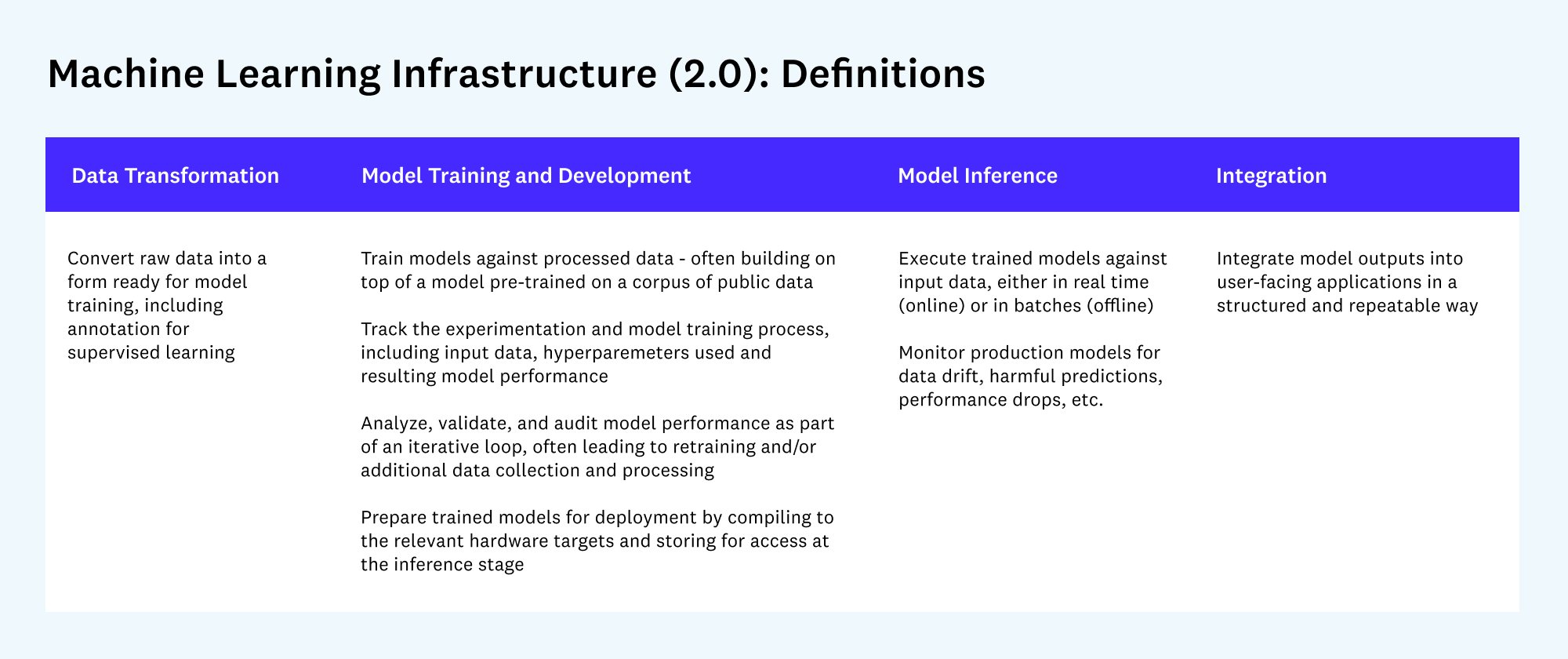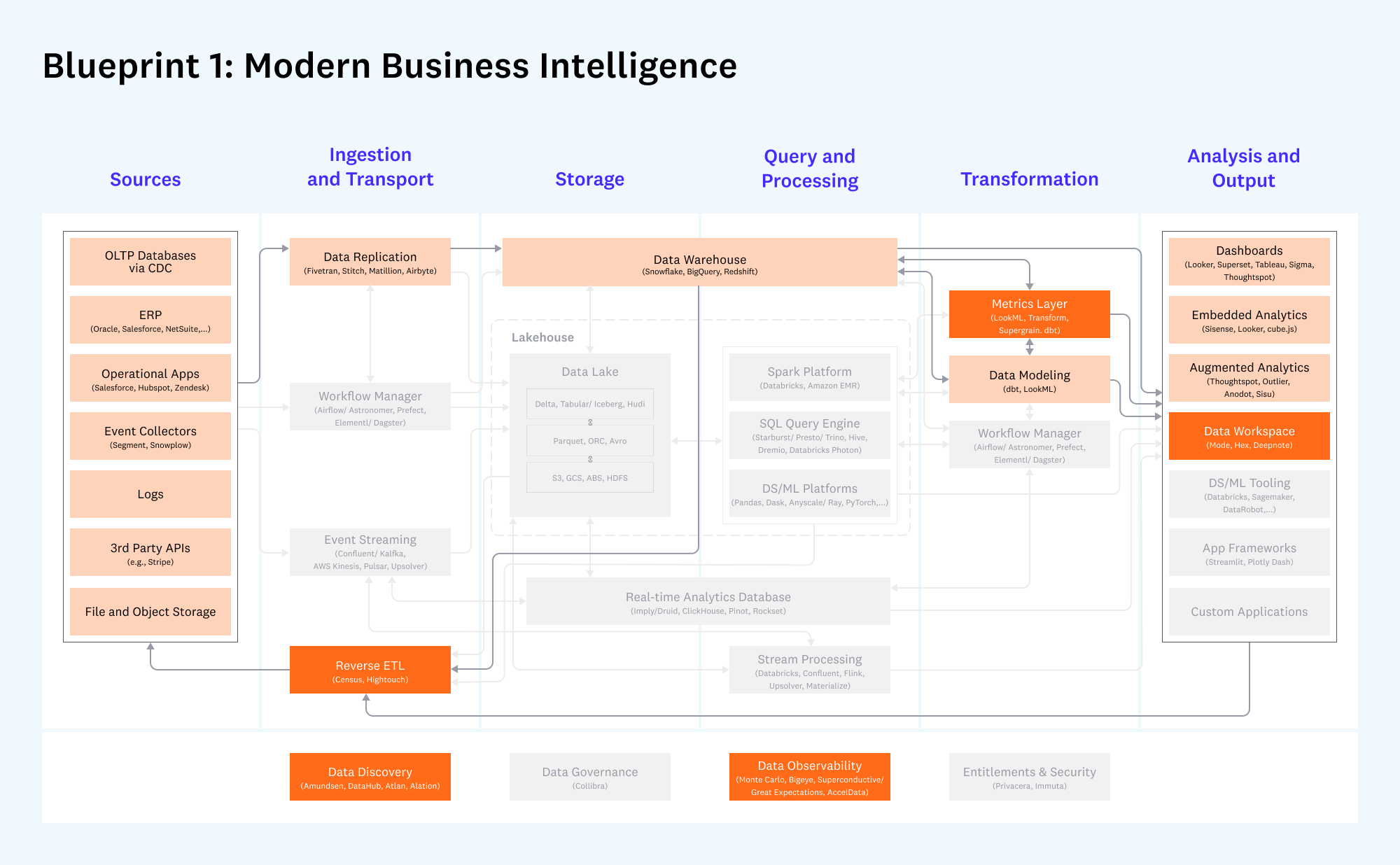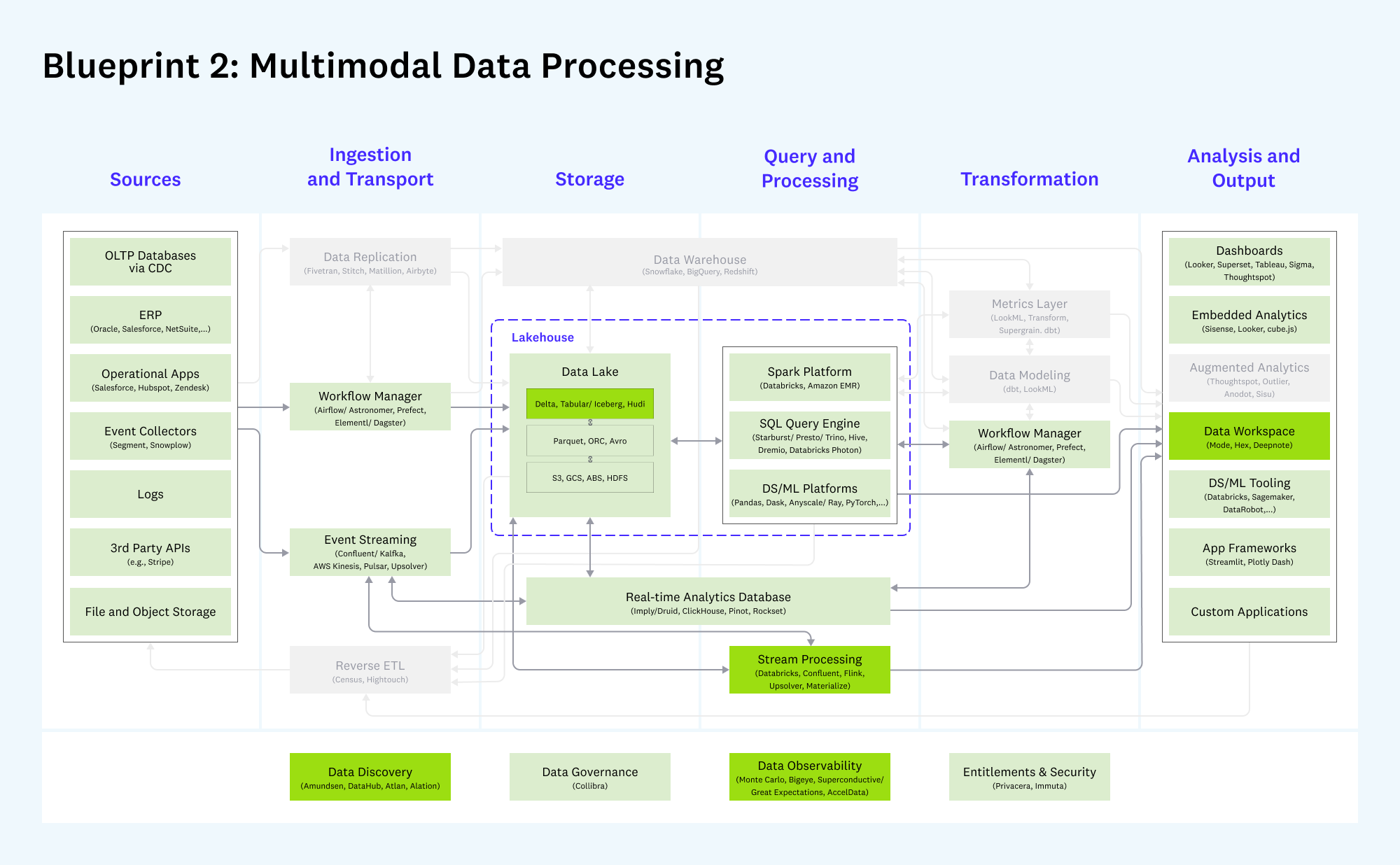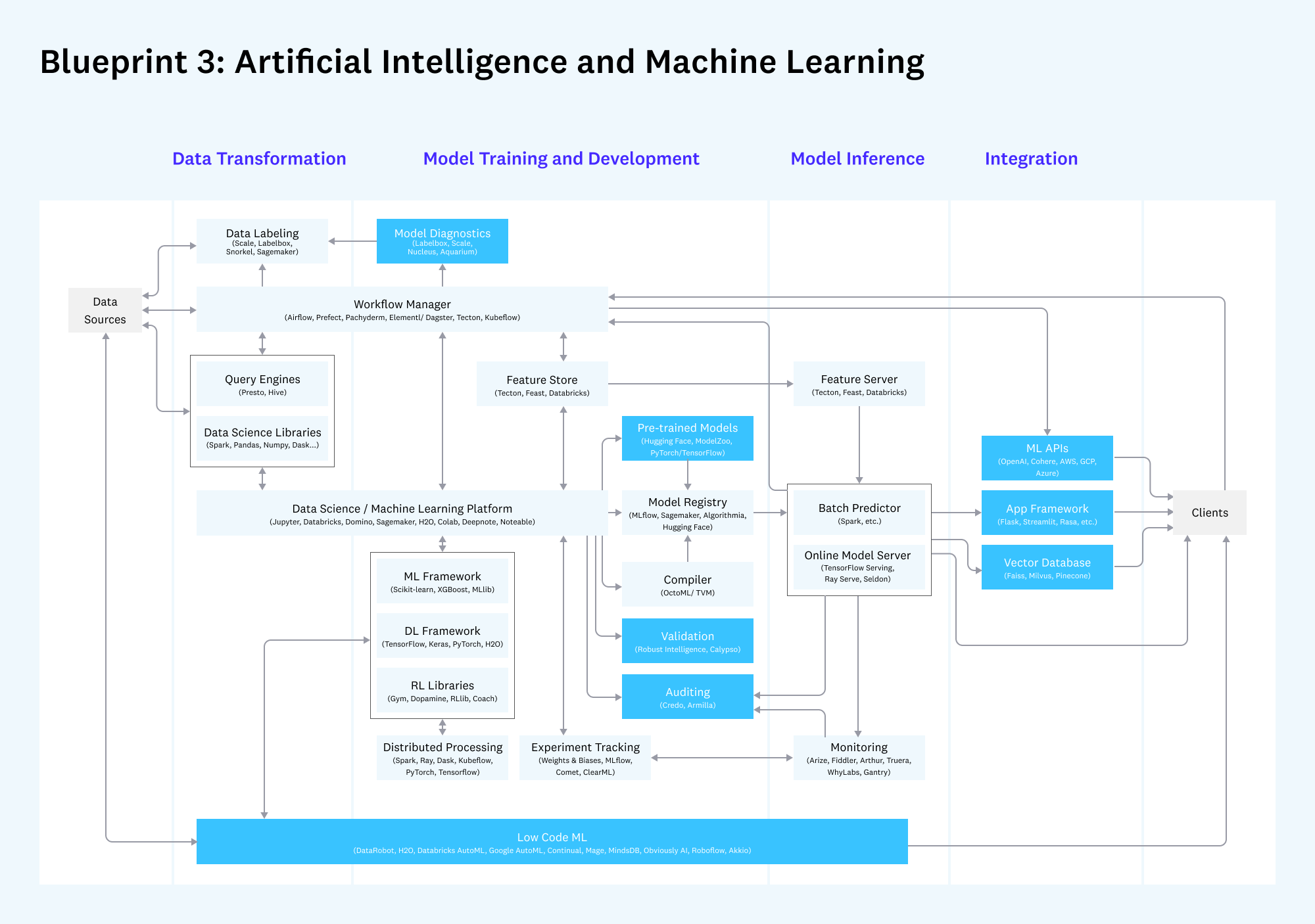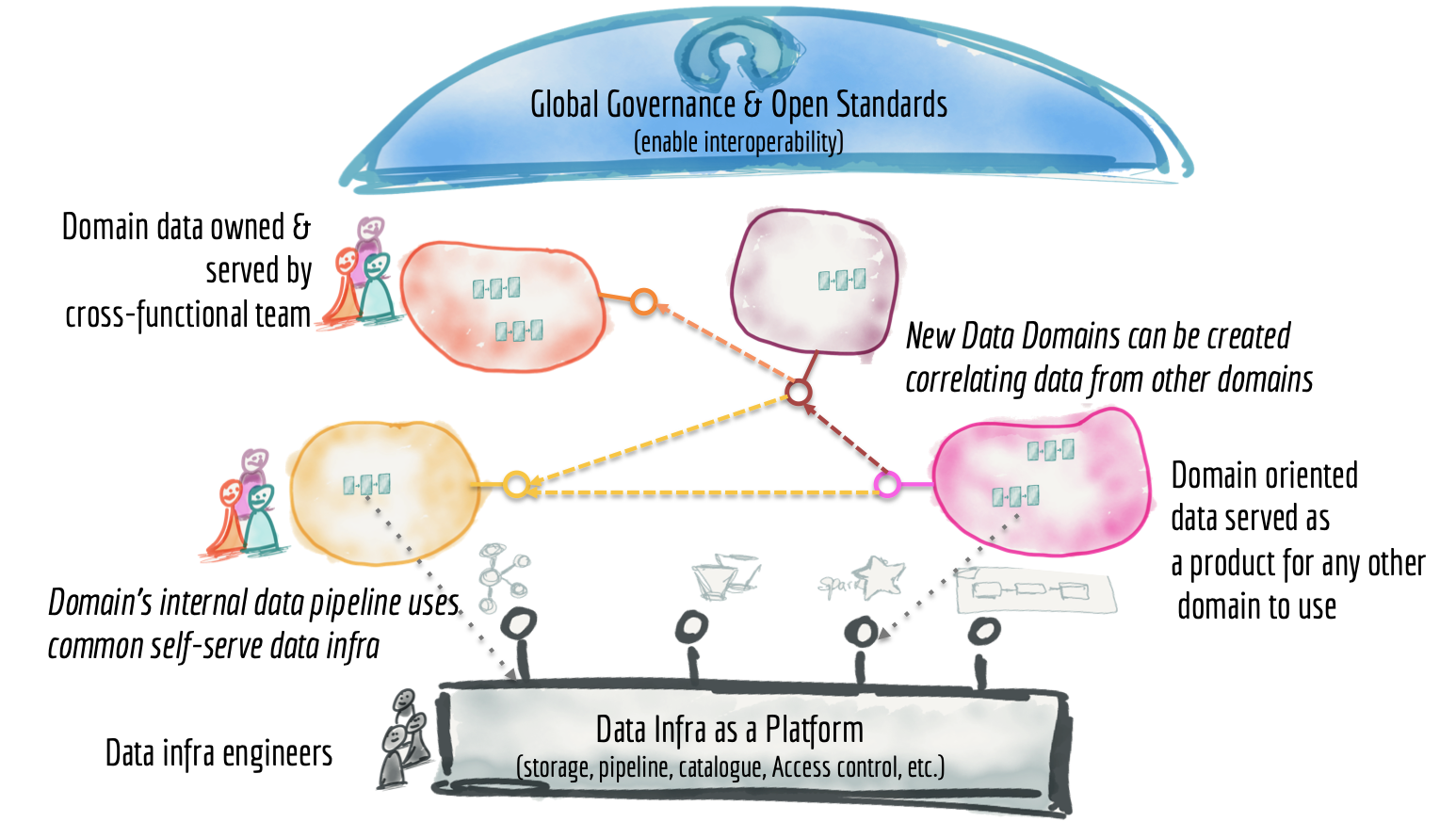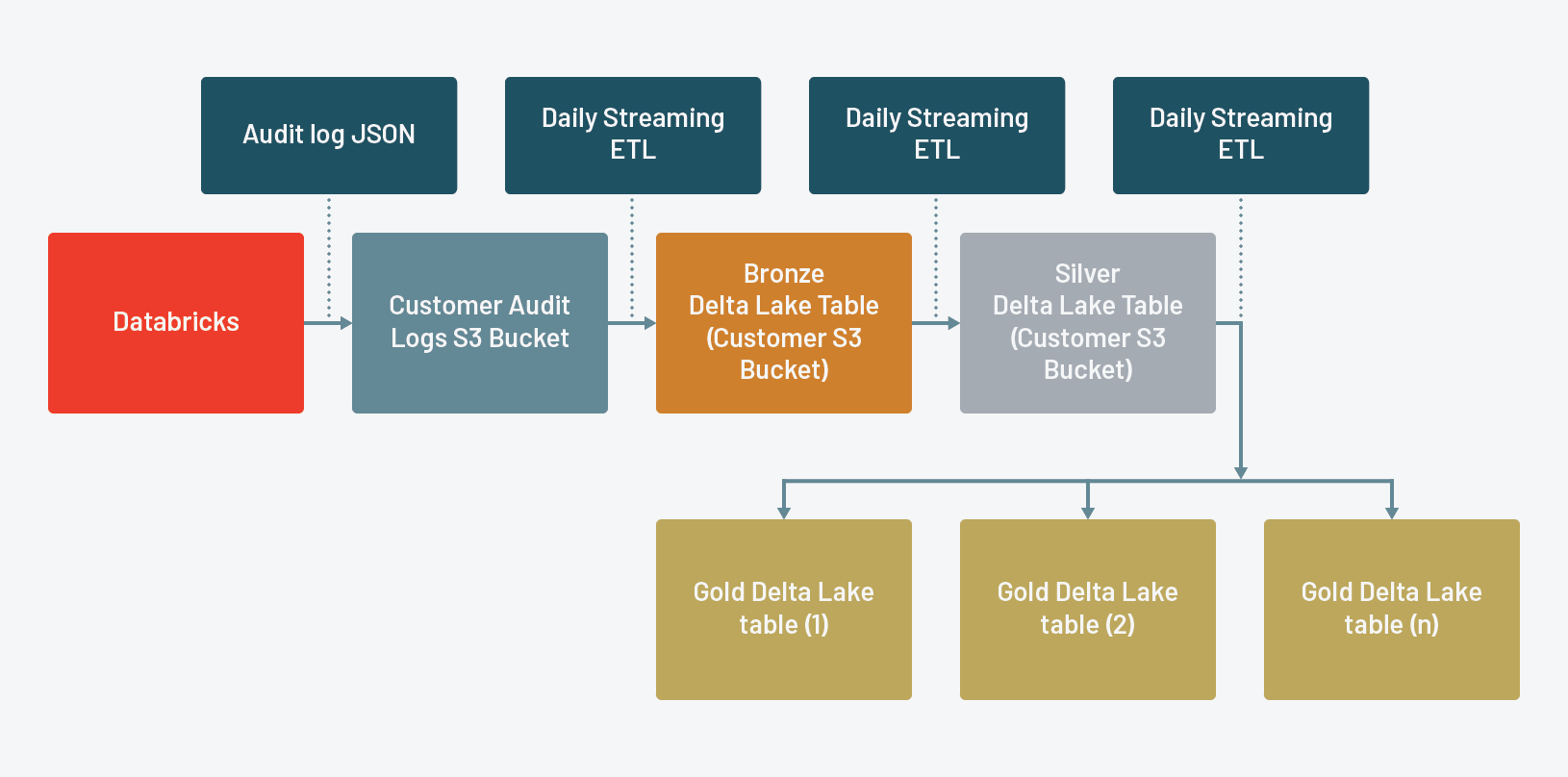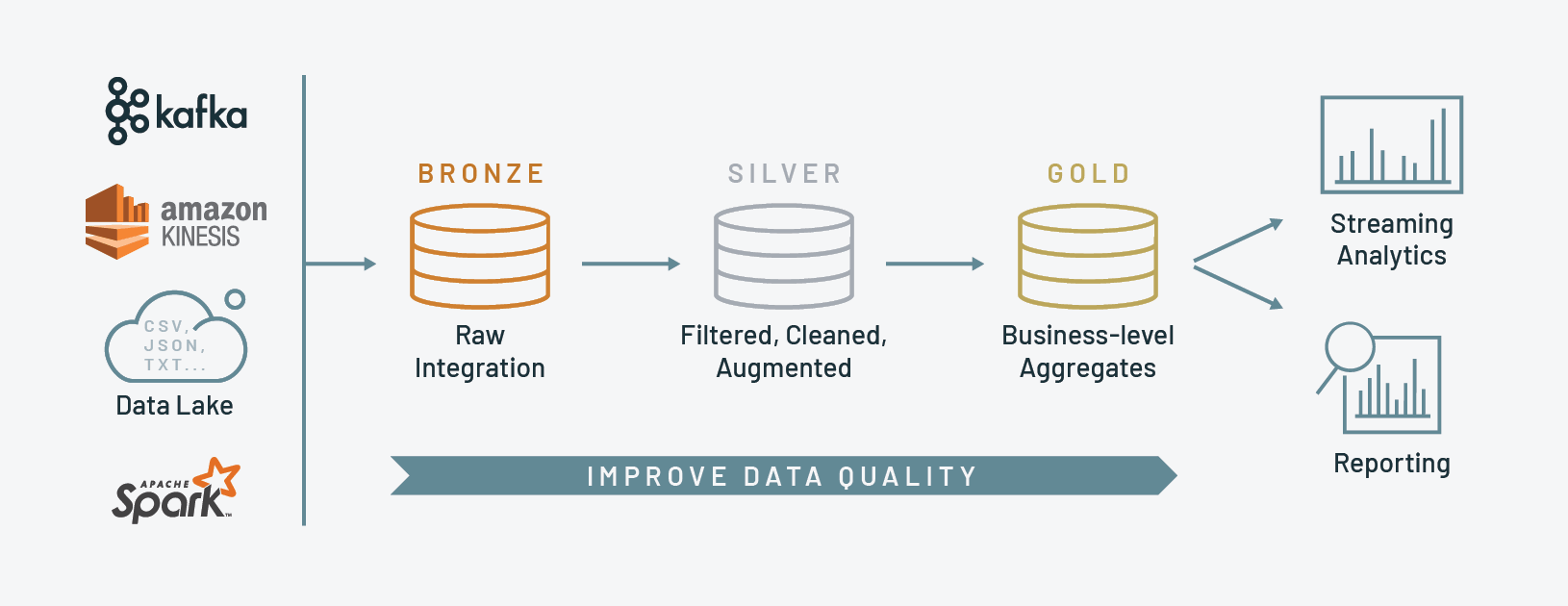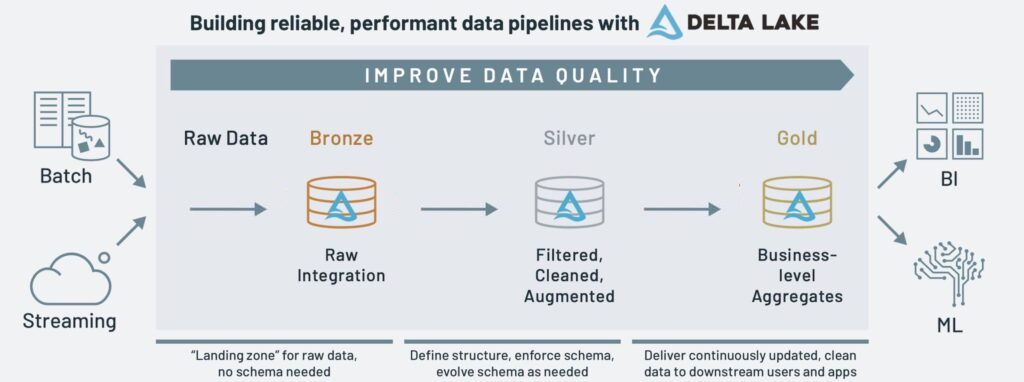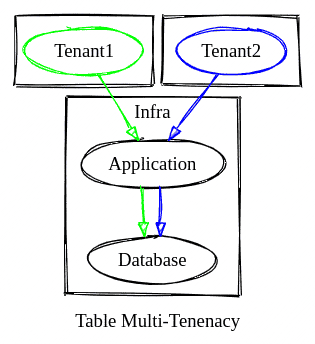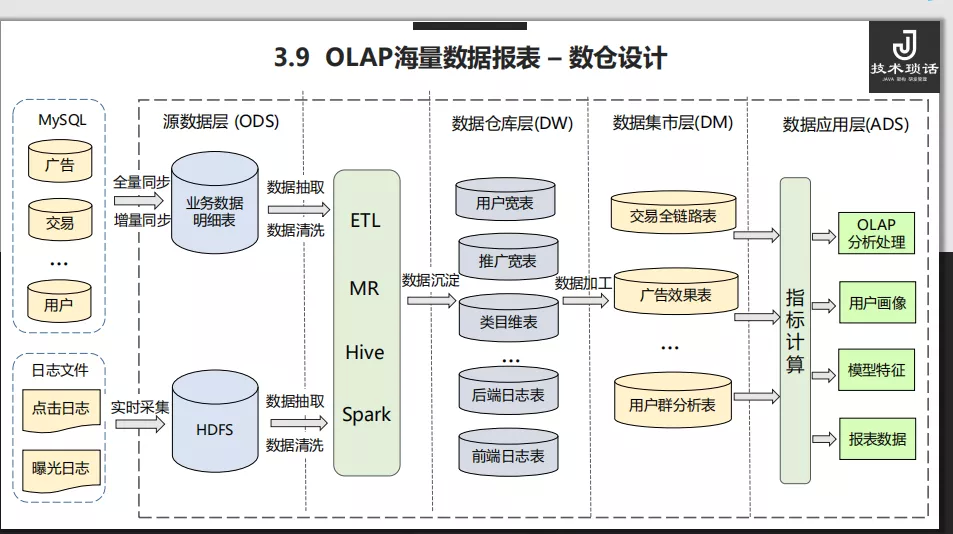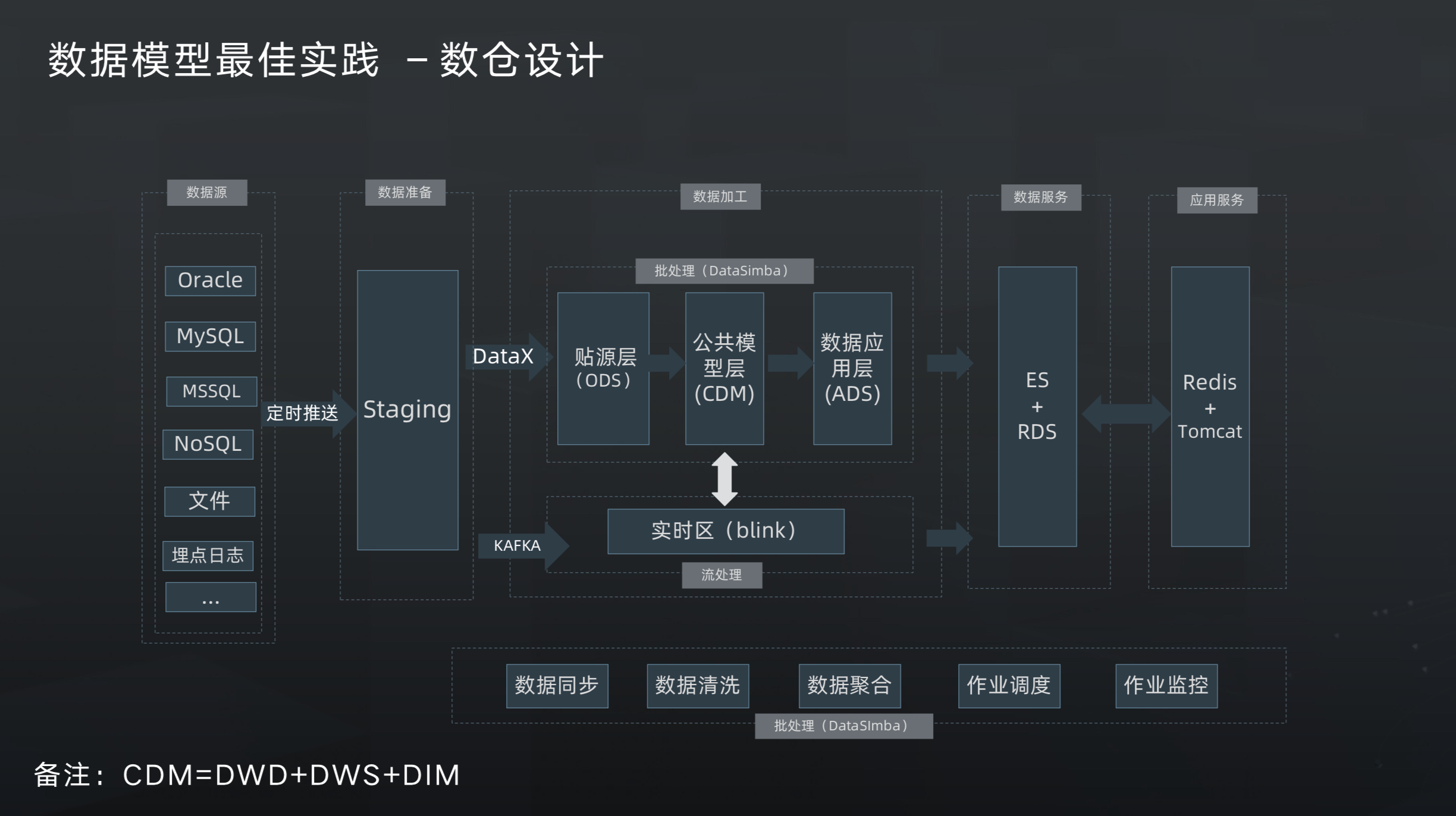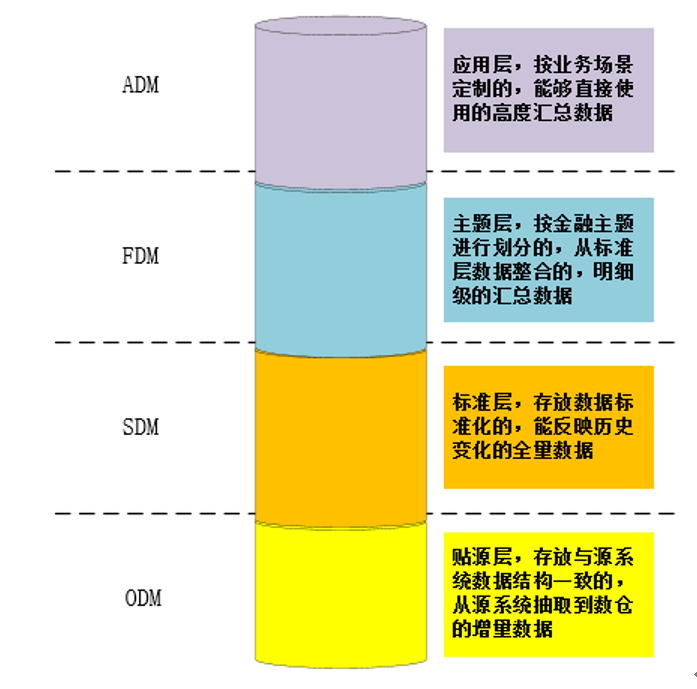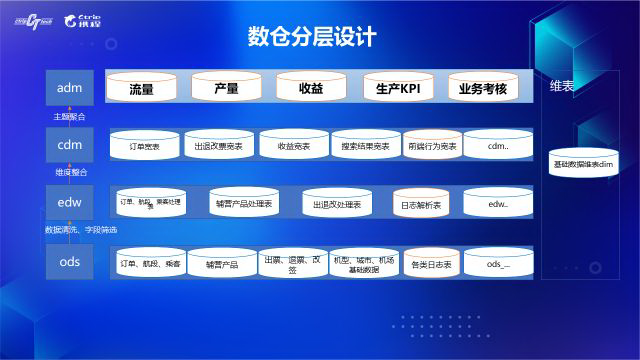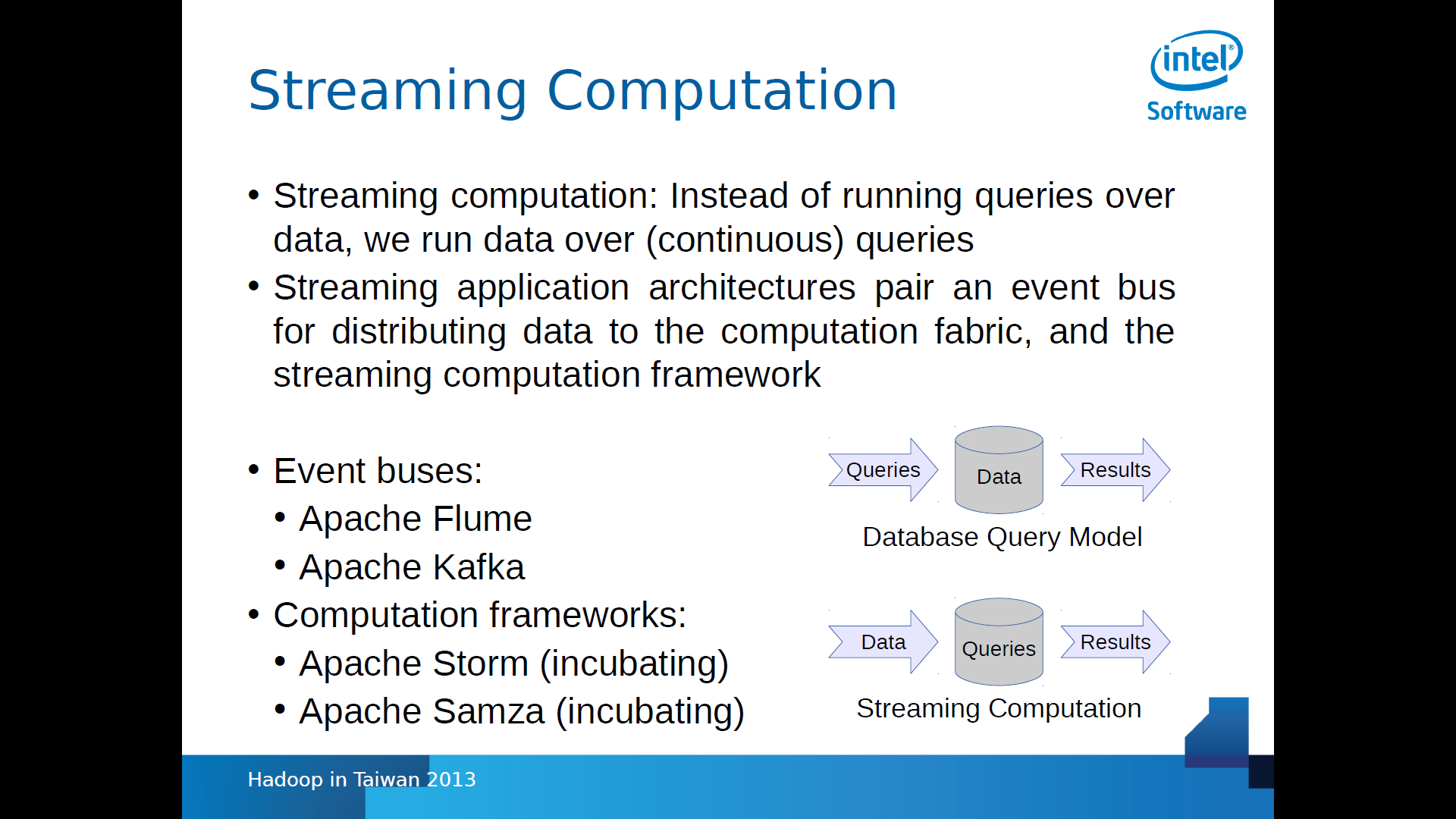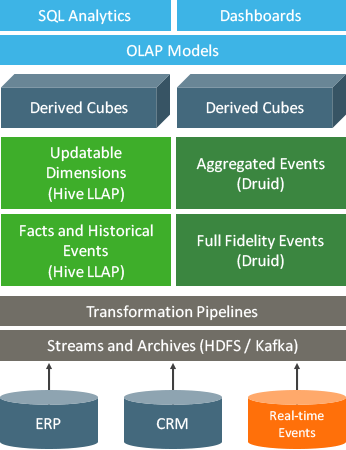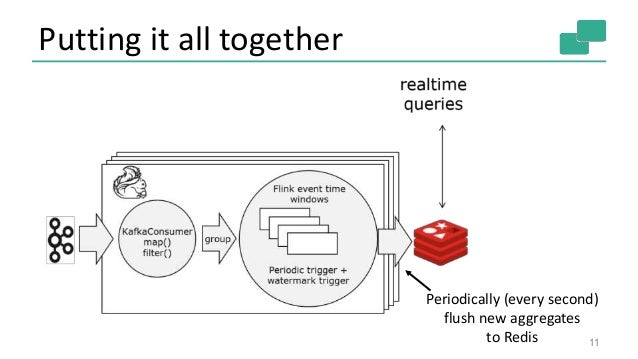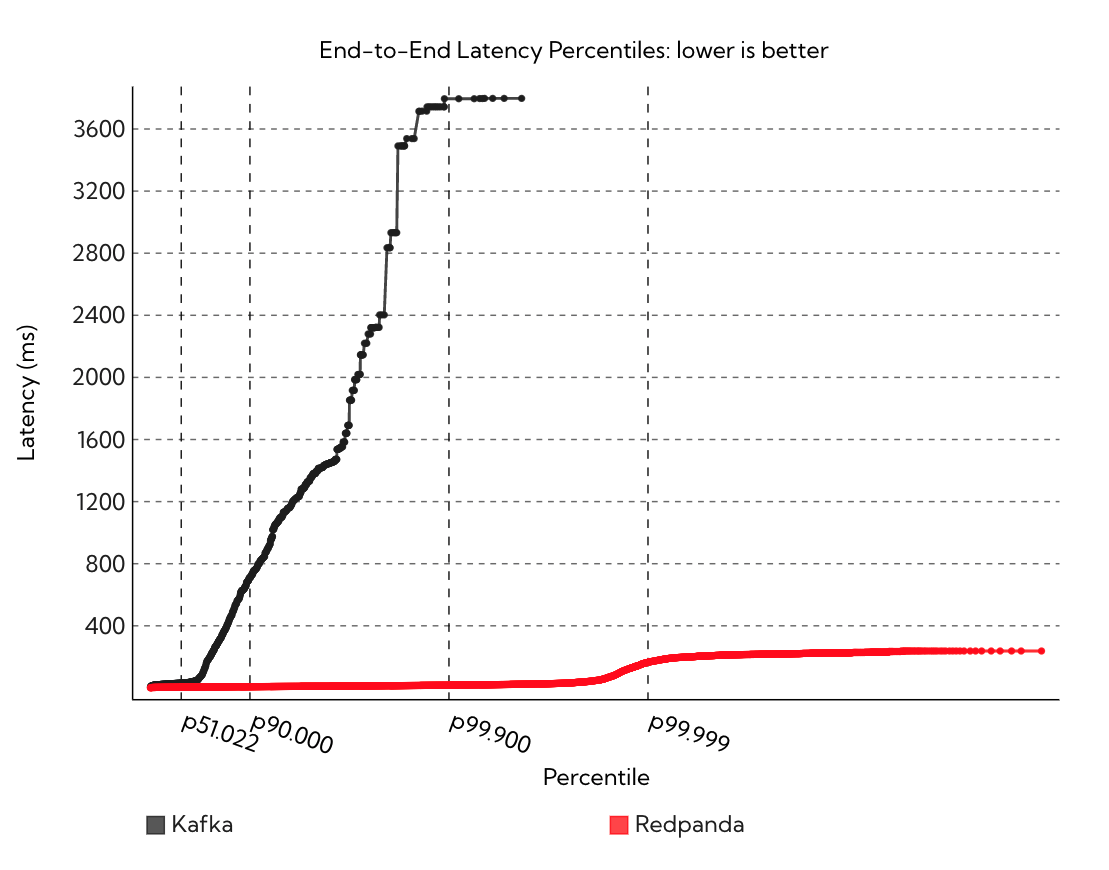-
-
Save leoricklin/f28a27d2fa718f6ef06960718442c859 to your computer and use it in GitHub Desktop.
Why
What is Data Mesh
How to Design a Data Mesh
Mesh
20220928 The Top Three Entangled Trends in Data Architectures: Data Mesh, Data Fabric, and Hybrid Architectures - Cloudera Blog, EN, ★★★
Figure 1. Data mesh conceptual hierarchy
Figure 2. Data mesh example
- A1, A2 are data apps
- D1, D2, etc., are data products
- Apps subscribe to data products and produce data products
Figure 3. Data mesh concepts mapping to data fabric entities
Figure 4. Data fabric implementation corresponding to data mesh example in Figure 2
- D1, D2 are tables in a data warehouse
- A1 is an app with ingestion and an SQL statement pipeline orchestrated to run on a certain schedule
- A2 is an app built as a spark job orchestrated to run when some data shows up
Table Multi-Tenancy
Schema Multi-Tenancy
Database Multi-Tenancy
The 3 characteristics of a modern data platform
- Enable self-service for a diverse range of users
- Enable “agile” data management
- Flexible, fast set-up, and pay-as-you-go
20220117 Part 3 – Data Modeling in Data Warehouses, Data Lakes, and Lake Houses. - Confessions of a Data Guy, EN, ★★★
Data Lakes and Houses will contain Accumulators and Descriptors, not nessesiarly Facts and Dimensions.
The only reason I don’t like to call Fact tables Fact tables in Data Lakes, and Dimensions as Dimensions, is because of the historical context around Fact and Dimensions and all that entails. It gives a certain impression about the Data Model under discussion, and I like to make distinctions.
Accumulators
Accumulators in a Data Lake aggregate or accumulate the transactional records, pretty much like a Fact table would have in the past. The main difference will be that the Accumulator table will probably contain fewer “keys” that point to other tables, that would most likely have been stripped out and put into a Dimension table in the classic SQL Kimball model.
Descriptors
The Descriptors in the new Data Lake or Lake House are exactly like Dimensions, again they are just less broken up and normalized, there are just fewer of them. If the business requires say some distinct list of addresses, that would just be done an additional sub table probably run and filled much like a Data Mart or analytic further downstream. It wouldn’t be built into the Descriptor Tables and given keys that are referen ced in an Accumulator table.
20210602 How Airbnb Standardized Metric Computation at Scale | by Amit Pahwa | The Airbnb Tech Blog | Medium, EN
At the heart of Minerva’s configuration system are event sources and dimension sources, which correspond to fact tables and dimension tables in a Star Schema design, respectively.
Figure 1: Event sources and dimension sources are the fundamental building blocks of Minerva.
Figure 3: Programmatic denormalization generates dimension sets which users can easily configure.
20201222 7 most common data preparation transformations in AWS Glue DataBrew | AWS Big Data Blog, EN, ★★★
#1 Handling/Imputing missing values #2 Combining datasets #3 Creating columns #4 Filtering data #5 Aggregating data #6 Handling Categorical values #7 Handling Numerical values
20201130 前亚马逊工程师:广告系统架构解密-InfoQ, EN, https://www.infoq.cn/article/1YwEyLTGTI5bigENuklx
数据报表是也是广告平台的核心业务,它是广告主、平台运营人员进行投放优化、业务决策的依据。先来看下广告数据仓库的分层结构:
- 源数据层 :对应各种源数据,包括 HDFS 中实时采集的前后端日志,增量或者全量同步的 MySQL 业务数据表。
- 数据仓库层 :包含维度表和事实表,通常是对源数据进行清洗后的数据宽表,比如行为日志表、推广宽表、用户宽表等。
- 数据集市层 :对数据进行轻粒度的汇总表,比如广告效果表、用户行为的全链路表、用户群分析表等。
- 数据应用层 :上层应用场景直接使用的数据表,包括多维分析生成的各种收入报表、Spark 任务产出的算法模型特征和画像数据等。
采用这样的分层结构,和软件分层思想类似,提高了数据的维护性和复用性。
再来看应用层报表部分面临的挑战:聚合维度多,需要分时、分广告位、分推广等几十个维度;单表最大达到百亿级别;支持时间范围的实时查询。
20200908 浅谈银行的数据仓库——分层架构 - InfoQ, EN, https://www.infoq.cn/article/KJzDGU6IkWKyaPZXbFkB
-
ODM(Origin Data Manager)贴源层
主要用于源系统提供的 T-1 增量文本数据按源系统一致的数据结构入库到数据库。
-
SDM(Standard Data Manager)标准层 (@@CDM)
SDM 的数据处理主要分为两部分,一部分是源数据清洗及标准化 (@@ DWD@CDM),另一部分是合并全量数据 (@@ DWS@CDM)。
-
FDM(Finance Data Manager)金融主题层
为了让复杂的源数据变得容易理解及使用,必须按照相同的金融主题把数据整合到同一套模型中,对 SDM 数据进行明细级的数据整合汇总。
-
ADM(Application Data Manager)应用层
应用层就是以特定业务场景为目标而高度汇总的数据,一般以数据集市的形态呈现,比如大家常说的营销集市、风险集市、绩效集市。由于数据集市的建设对应的是特定且独立的业务场景,几无共性可言,所以必须对每类集市进行单独说明。
20200224 携程机票数据仓库建设之路 - InfoQ, EN, https://www.infoq.cn/article/vKigQ4Pvzwb3fYMB0l1C
分层设计主要参考公司推行的数据规范,将数据仓库的流程分成了生产镜像层(ods)、中间层(edw)、公共数据层(cdm)及应用数据层(adm)。
- 在中间层 (edw) 对 ods 表做异常数据剔除、NULL 值处理、枚举值统一等数据清理和绑定维表信息工作,
- 在公共数据层 (cdm) 对中间层表进行进一步的整合,丰富表主题的维度和度量,一般以宽表的形式呈现,用以后续的 adhoc 取数、报表。
大数据计算服务(MaxCompute,原名ODPS)是一种快速、完全托管的TB/PB级数据仓库解决方案。MaxCompute向用户提供了完善的数据导入方案以及多种经典的分布式计算模型,能够更快速的解决用户海量数据计算问题,有效降低企业成本,并保障数据安全。
-
表概述
-
表设计规范
-
表设计最佳实践
-
MaxCompute表的高级功能
Cube is the headless business intelligence platform. It helps data engineers and application developers access data from modern data stores, organize it into consistent definitions, and deliver it to every application.
Measures are referred to as quantitative data, such as number of units sold, number of unique visits, profit, and so on.
Dimensions are referred to as categorical data, such as state, gender, product name, or units of time (e.g., day, week, month).
REST API enables Cube to deliver data over the HTTP protocol to certain kinds of data applications, including but not limited to the following ones:
- Dealing with these issues involves SCD management methodologies referred to as Type 0 through 6.
- Type 1: overwrite
- Type 2: add new row
Abstract
When presented with a new dataset, human data scientists explore it in order to identify salient properties of the data elements, identify relationships between entities, and write processing software that makes use of those relationships accordingly. While there has been progress made on automatically processing the data to generate features or models, most automation systems rely on receiving a data model that has all the meta information about the data, including salient properties and relationships. In this thesis, we present a first version of our system, called ADELAutomatic Data Elements Linking. Given a collection of files, this system generates a relational data schema and identifies other salient properties. It detects the type of each data field, which describes not only the programmatic data type but also the context in which the data originated, through a method called Type Detection. For each file, it identifies the field that uniquely describes each row in it, also known as a Primary Key. Then, it discovers relationships between different data entities with Relationship Discovery, and discovers any implicit constraints in the data through Hard Constraint Discovery. We posit two out of these four problems as learning problems.
To evaluate our algorithms, we compare the results of each to a set of manual annotations. For Type Detection, we saw a max error of 7%, with an average error of 2.2% across all datasets. For Primary Key Detection, we classified all existing primary keys correctly, and had one false positive across five datasets. For Relationship Discovery, we saw an average error of 5.6%. (Our results are limited by the small number of manual annotations we currently possess.)
We then feed the output of our system into existing semi-automated data science software systems – the Deep Feature Synthesis (DFS) algorithm, which generates features for predictive models, and the Synthetic Data Vault (SDV), which generates a hierarchical graphical model. When ADEL’s data annotations are fed into DFS, it produces similar or higher predictive accuracy in 3/4 problems, and when they are provided to SDV, it is able to generate synthetic data with no constraint violations.
Automatic detection and inference of relationships in Power Pivot
One of the advantages to importing data using the Power Pivot add-in is that Power Pivot can sometimes detect relationships and create new relationships in the Data Model it creates in Excel.
When you import multiple tables, Power Pivot automatically detects any existing relationships among the tables. Also, when you create a PivotTable, Power Pivot analyzes the data in the tables. It detects possible relationships that have not been defined, and suggests appropriate columns to include in those relationships.
The detection algorithm uses statistical data about the values and metadata of columns to make inferences about the probability of relationships.
DataCleaner: DataCleaner is a Data Quality toolkit that allows you to profile, correct and enrich your data. People use it for ad-hoc analysis, recurring cleansing as well as a swiss-army knife in matching and Master Data Management solutions.
Community Edition, https://datacleaner.github.io/
Commercial Edtion, https://datacleaner.org/
SQLFlow: Visualize column impact and data lineage to track columns across transformations by analyzing SQL query
SQL Lineage Analysis Tool powered by Python, https://pypi.org/project/sqllineage/
Behind the scene, SQLLineage uses the fantastic sqlparse library to parse the SQL command, and bring you all the human-readable result with ease.
Open-source data integration for modern data teams
- Extract from sources: use pre-built or custom connectors
- Load to destination: through UI or API
- Transform: raw or normalized, with dbt-based transformation
- full ingestion
- segmented ingestion
- incremental ingestion
Singer describes how data extraction scripts—called “taps” —and data loading scripts—called “targets”— should communicate, allowing them to be used in any combination to move data from any source to any destination. Send data between databases, web APIs, files, queues, and just about anything else you can think of.
Features
- Unix-inspired: Singer taps and targets are simple applications composed with pipes—no daemons or complicated plugins needed.
- JSON-based: Singer applications communicate with JSON, making them easy to work with and implement in any programming language. Singer also supports JSON Schema to provide rich data types and rigid structure when needed.
- Efficient: Singer makes it easy to maintain state between invocations to support incremental extraction.
Fivetran is the automated data movement platform moving data out of, into and across your cloud data platforms.
20151013 Data Vault Series (1) – Agile Modeling: Not an Option Anymore, EN, https://www.vertabelo.com/blog/technical-articles/data-vault-series-agile-modeling-not-an-option-anymore
20151020 Data Vault Series (2) – Data Vault 2.0 Modeling Basics, EN, https://www.vertabelo.com/blog/technical-articles/data-vault-series-data-vault-2-0-modeling-basics
20151103 Data Vault Series (3) – The Business Data Vault, EN, https://www.vertabelo.com/blog/technical-articles/data-vault-series-the-business-data-vault
20151117 Data Vault Series (4) – Building an Information Mart With Your Data Vault, EN, https://www.vertabelo.com/blog/technical-articles/data-vault-series-building-an-information-mart-with-your-data-vault
Introduction to Data Vault 2.0 Boot Camp, https://youtu.be/Br3EkI9E1ns
How long does the access last? This comes with lifetime access to the content. Lifetime access is the lifetime of our company and our ability to support this.
20200130 The Data Ops Cookbook: Methodologies and Tools That Reduce Analytics Cycle Time While Improving Quality
Understand DataOps in the context of a century-long evolution of ideas that improve how people manage complex systems. It started with pioneers like W. Edwards Deming and statistical process control - gradually these ideas crossed into the technology space in the form of Agile, DevOps and now, DataOps.
This project describes the data contract being used in the implementation of Data Mesh at PayPal. It is available for you as an Apache 2.0 license. Contributions are welcome!
The basics of a data contract
A data contract defines the agreement between a data producer and consumer. A data contract contains several sections:
- Fundamentals.
- Schema.
- Data quality.
- Service-level agreement (SLA).
- Security & stakeholders.
- Custom properties.
| Title | Content |
|---|---|
| (1) Continually satisfy your customer: | Our highest priority is to satisfy the customer through the early and continuous delivery of valuable analytic insights from a couple of minutes to weeks. |
| (2) Value working analytics: | We believe the primary measure of data analytics performance is the degree to which insightful analytics are delivered, incorporating accurate data, atop robust frameworks and systems. |
| (3) Embrace change: | We welcome evolving customer needs, and in fact, we embrace them to generate competitive advantage. We believe that the most efficient, effective, and agile method of communication with customers is face-to-face conversation. |
| (4) It’s a team sport: | Analytic teams will always have a variety of roles, skills, favorite tools, and titles. A diversity of backgrounds and opinions increases innovation and productivity. |
| (5) Daily interactions: | Customers, analytic teams, and operations must work together daily throughout the project. |
| (6) Self-organize: | We believe that the best analytic insight, algorithms, architectures, requirements, and designs emerge from self-organizing teams. |
| (7) Reduce heroism: | As the pace and breadth of need for analytic insights ever increases, we believe analytic teams should strive to reduce heroism and create sustainable and scalable data analytic teams and processes. |
| (8) Reflect: | Analytic teams should fine-tune their operational performance by self-reflecting, at regular intervals, on feedback provided by their customers, themselves, and operational statistics. |
| (9) Analytics is code: | Analytic teams use a variety of individual tools to access, integrate, model, and visualize data. Fundamentally, each of these tools generates code and configuration which describes the actions taken upon data to deliver insight. |
| (10) Orchestrate: | The beginning-to-end orchestration of data, tools, code, environments, and the analytic teams work is a key driver of analytic success. |
| (11) Make it reproducible: | Reproducible results are required and therefore we version everything: data, low-level hardware and software configurations, and the code and configuration specific to each tool in the toolchain. |
| (12) Disposable environments: | We believe it is important to minimize the cost for analytic team members to experiment by giving them easy to create, isolated, safe, and disposable technical environments that reflect their production environment. |
| (13) Simplicity: | We believe that continuous attention to technical excellence and good design enhances agility; likewise simplicity–the art of maximizing the amount of work not done–is essential. |
| (14) Analytics is manufacturing: | Analytic pipelines are analogous to lean manufacturing lines. We believe a fundamental concept of DataOps is a focus on process-thinking aimed at achieving continuous efficiencies in the manufacture of analytic insight. |
| (15) Quality is paramount: | Analytic pipelines should be built with a foundation capable of automated detection of abnormalities (jidoka) and security issues in code, configuration, and data, and should provide continuous feedback to operators for error avoidance (poka yoke). |
| (16) Monitor quality and performance: | Our goal is to have performance, security and quality measures that are monitored continuously to detect unexpected variation and generate operational statistics. |
| (17) Reuse: | We believe a foundational aspect of analytic insight manufacturing efficiency is to avoid the repetition of previous work by the individual or team. |
| (18) Improve cycle times: | We should strive to minimize the time and effort to turn a customer need into an analytic idea, create it in development, release it as a repeatable production process, and finally refactor and reuse that product. |
What Does a DataOps Lifecycle Look Like?
A DataOps cycle has eight stages: planning, development, integration, testing, release, deployment, operation, and monitoring. A DataOps engineer must be well versed in all of these stages in order to have a seamless DataOps infrastructure.
- Planning
Partnering with product, engineering, and business teams to set KPIs, SLAs, and SLIs for the quality and availability of data.
- Development
Building the data products and machine learning models that will power your data application.
- Integration
Integrating the code and/or data product within your existing tech and or data stack. For example, you might integrate a dbt model with Airflow so the dbt module can automatically run.
- Testing
Testing your data to make sure it matches business logic and meets basic operational thresholds (such as uniqueness of your data or no null values).
- Release
Releasing your data into a test environment.
- Deployment
Merging your data into production.
- Operate
Running your data into applications such as Looker or Tableau dashboards and data loaders that feed machine learning models.
- Monitor
Continuously monitoring and alerting for any anomalies in the data
Meltano embraces the Singer standard and its community-maintained library of open source extractors and loaders, and leverages dbt for transformation.
- Your Meltano project: a single source of truth
- Integration just a few keystrokes away
- Transformation as a first-class citizen
- Orchestration right out of the box
- Instantly containerizable and production-ready
- A UI for management and monitoring
An open-source workflow management system
Task runner overview
You can use the .submit() method on a task function to submit the task to a task runner. Using a task runner enables you to control whether tasks run sequentially, concurrently, or if you want to take advantage of a parallel or distributed execution library such as Dask or Ray.
Using the .submit() method to submit a task also causes the task run to return a PrefectFuture, a Prefect object that contains both any data returned by the task function and a State, a Prefect object indicating the state of the task run.
Prefect currently provides the following built-in task runners:
SequentialTaskRunnercan run tasks sequentially.ConcurrentTaskRunnercan run tasks concurrently, allowing tasks to switch when blocking on IO. Tasks will be submitted to a thread pool maintained by anyio.
Using results from submitted tasks
from prefect import flow, task
@task
def my_task():
return 42
@flow
def my_flow():
future = my_task.submit()
result = future.result(raise_on_failure=False)
if future.get_state().is_failed():
# `result` is an exception! handle accordingly
...
else:
# `result` is the expected return value of our task
print(result)
...
#
my_flow()
You may also use the wait_for=[] parameter when calling a task, specifying upstream task dependencies. This enables you to control task execution order for tasks that do not share data dependencies.
@task
def task_a():
pass
@task
def task_b():
pass
@task
def task_c():
pass
@task
def task_d():
pass
@flow
def my_flow():
a = task_a.submit()
b = task_b.submit()
# Wait for task_a and task_b to complete
c = task_c.submit(wait_for=[a, b])
# task_d will wait for task_c to complete
# Note: If waiting for one task it must still be in a list.
d = task_d(wait_for=[c])
- API
- Functional API
- Imperative API
This module contains a task for interacting with dbt via the shel.
-
Tasks
Prefect refers to each step as a task. In a simple sense, a task is nothing more than a Python function. In fact, the easiest way to create a new task is just by decorating an existing function. Let's make a simple task that prints "Hello, world!":
Prefect has no restrictions on how much or how little each task can do. In general, we encourage "small tasks" over monolithic ones: each task should perform a discrete logical step of your workflow, but not more. This is because the Prefect engine does a lot of work to handle each task, including checkpointing the state after each task runs. Therefore, the more tasks you have, the more opportunities the engine has to be helpful.
-
Task inputs and outputs
Prefect tasks can optionally receive inputs and produce outputs. To take advantage of this feature, provide them in your task definition.
-
-
Flows
In Prefect, flows are used to describe the dependencies between tasks, such as their order or how they pass data around. If tasks are like functions, then you could think of a flow as a script that combines them in interesting ways.
-
Functional API
Here is a flow that uses the add task we wrote earlier to add a few numbers together. Notice how tasks can accept numbers or even other tasks as inputs; Prefect automatically creates the appropriate connections (or "edges") in the flow graph. In addition, notice that we call add twice, generating two distinct copies of our task in the flow:
-
Running the flow
-
Parameters
Sometimes, it's useful to provide information to a flow at runtime. Prefect provides a special task called a Parameter for this purpose.
-
Imperative API
The functional API makes it easy to define workflows in a script-like style. Sometimes, you may prefer to build flows in a more programmatic or explicit way. For this, we can use Prefect's imperative API.
-
https://stackoverflow.com/questions/59954398/how-to-handle-a-task-failure-in-prefect-and-return-success-with-the-on-failure-p
Dagster is a data orchestrator for machine learning, analytics, and ETL
(Using dbt with Dagster)[https://docs.dagster.io/integrations/dbt]
Arc is an opinionated framework for defining predictable, repeatable and manageable data transformation pipelines;
- predictable in that data is used to define transformations - not code.
- repeatable in that if a job is executed multiple times it will produce the same result.
- manageable in that execution considerations and logging have been baked in from the start
Currently it is tightly coupled to Apache Spark due to its fault-tolerance, performance and solid API for standard data engineering tasks but the definitions are human and machine readable HOCON (a JSON derivative) allowing the transformation definitions to be implemented against future execution engines.
- What is DataOps’ intellectual heritage?
- What is Agile Development?
- What is lean manufacturing and what does it have to do with data analytics?
- What is DevOps?
- Isn’t DataOps just DevOps for Data?
- What problem is DataOps trying to solve?
- What does a DataOps organization look like?
- What is a DataOps Engineer?
- How do you prove that DataOps is really adding value?
- What is a DataOps Platform?
- Every tool vendor claims to do DataOps. Has the term lost its meaning?
- Should I be skeptical of the hype around DataOps?
- Where can I learn more about DataOps?
- [White Paper] DataOps is NOT Just DevOps for Data
- [White Paper] The Seven Steps to Implement DataOps
- [Blog] For Data Team Success, What You Do is Less Important than How You Do It
- [Blog] A Guide to Understanding DataOps Solutions
- [Webinar] Why Do DataOps?
- [Webinar] Real-Life Examples to Inspire Your DataOps Initiative
- [YouTube] DataOps Videos
Great Expectations is the leading tool for validating, documenting, and profiling your data to maintain quality and improve communication between teams. Head over to our getting started tutorial.
On-the-fly Aggregation with MySQL®
- Pros
- Reliable database capable of handling high read/write volumes
- Able to support near-real-time data, as MySQL can be updated from streaming data sources
- Cons
- Complex aggregation queries of large datasets are not as performant as we would like and could bottleneck the MySQL instance as we continue to grow and the data size gets larger
- We would need to upsert records in a batch to ensure historical data is up to date. Frequent and large batch inserts would reduce the performance of SELECT queries in flight
Pre-Aggregation of data with MySQL
- Pros
- Since data is pre-aggregated before loading into MySQL, queries are very efficient as they can completely leverage MySQL indexes to pull a single row of data
- Cons
- Unable to support near-real-time metrics, so pre-aggregations would need to be done in batches on a set cadence
- Similar to the solution above, we would need to upsert records in batch to ensure historical data is up to date which could cause performance issues
- We would need to pre-aggregate every necessary use case, potentially increasing the effort to maintain the service as new use cases with aggregation parameters arise down the line
Two OLTP Database Tables
One table stores raw events, and event updates trigger an asynchronous function to update all relevant metrics in the other, aggregated table.
- Pros
- Highly available, low query latency and eventually consistent
- Cons
- Hard to migrate event schema and redefine logic of metrics, because new metrics definition requires recalculation of all the pre-aggregated metrics
- Not very scalable, especially while writing traffic is high
OLAP with Apache Pinotᵀᴹ
Apache Pinot is a realtime, distributed and scalable datastore designed to execute analytical queries at ultra-low latencies required for user-facing analytics. A single logical table (aka hybrid table) can be set up for both real-time and offline ingestion based on the lambda architecture.
- Pros
- Carrier performance data can be measured in real time by leveraging Apache Flink® and Kafka®, then these performance metrics events can be ingested into the real-time portion of the hybrid Pinot table.
- Offline, cleaned data sources from HDFS can be used to fill the Offline portion of the hybrid Pinot table, ensuring any post-completion modifications to the shipment are accounted for.
- Pinot provides many indexing options to enable low-latency aggregations and data selection queries
- Cons
- Business logic would need to be maintained in two separate places. While we already maintain logic to define these performance metrics in offline HDFS, we would also need to keep our real time Flink logic up to date to ensure they output consistent data.
Neutrino Presto
Neutrino is a primary query gateway to access the Pinot datasets at Uber. It is a slightly different deployment of Presto® where a coordinator and a worker runs on each host and is capable of running each query independently. Neutrino is a stateless and scalable regular Java microservice hosted on Mesos containers. It accepts PrestoSQL query, translates it into Pinot query language, and routes it to appropriate Pinot clusters.
Caching
When users open or refresh the Carrier Scorecard in the mobile app, 5 metrics will be fetched concurrently, which translates to 9 Neutrino queries, due to some metrics requiring more than one Neutrino query. P99 latency of our Neutrino queries is around 60ms, in order to reduce traffic to Neutrino and improve external latency, we added a Redis cache in front of Neutrino, which stores aggregated metrics. A TTL of 12 hours was set and we use the following strategies to ensure cache consistency as new events continue to flow in. On average, we were able to achieve >90% cache hit rate.
Cache Aside: When the request key is not yet cached during a read (cache miss), we query Neutrino and store the resulting metrics in Redis.Event driven cache refreshing: When a raw milestone event occurs, we immediately invalidate all relevant keys in Redis. After a 2-minute wait period, we fetch the new results for all keys that were invalidated from Neutrino and update Redis. The 2-minute wait time is to ensure events were ingested into Pinot’s real-time table.
Architectural patterns for building real time applications with Apache HBase-HadoopTW 2013, EN, ★★★★★
[使用开源分布式存储系统Alluxio来有效的分离计算与存储], EN (https://www.infoq.cn/video/jumLKjEBIQJMmZNol08J)
Materialize is a streaming database for real-time applications. It lets you ask complex questions about your data using SQL, and incrementally maintains the results of these SQL queries up-to-date as the underlying data changes.
Welcome to the first virtual Hack Day hosted by Materialize and our good friends at Redpanda and dbt Labs! The goal of this event is to encourage knowledge-sharing between our communities (we've already learned so much just putting it together!), and give you a taste of what building streaming analytics pipelines with this stack looks like.
[20191120 Introducing ksqlDB](https://www.confluent.io/blog/intro-to-ksqldb-sql-database-streaming /)
Our motivation in focusing on this is very simple: building applications around event streams has been too complex thus far. Consider this common stream processing application architecture:
This is quite complex as it involves a number of different distributed systems, all of which have to be integrated, secured, monitored, and operated as one. It’s a pretty heavy-weight stack for one application! However, one could be forgiven for preferring the simple three-tier architecture of traditional CRUD applications that only need a single database for serving all its data needs.
We want ksqlDB to provide the same simplicity for event streaming applications that relational databases provide for CRUD applications.
ksqlDB allows us to simplify this architecture substantially. Now, there are just two things: Kafka and ksqlDB, bringing together the full set of components needed from connectors, to processing, to queries.
Redpanda is Kafka® compatible, ZooKeeper®-free, JVM-free and source available. Use all your favorite Kafka tooling without any code changes.
Step 1: Install Apache Kafka
Step 2: Load data
Step 3: Make the Kafka topics known to Trino
Step 4: Basic data querying
Step 5: Add a topic description file
Step 6: Map all the values from the topic message onto columns
Step 7: Use live data
Setup a live Twitter feed
Create a tweets table on Trino
Feed live data
Epilogue: Time stamps
